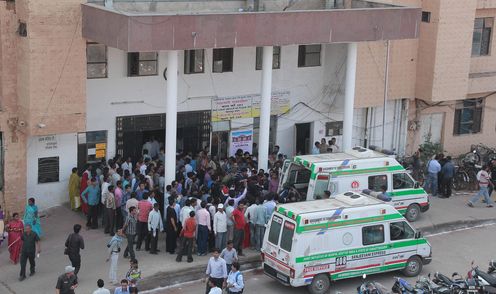
Public outcry, demonstrations and riots have followed the death of 13 women at a government female sterilisation camp in the Indian state of Chhattisgarh. Investigators have blamed tainted medicines and expect the death toll to rise as 20 women remain in hospital in the state capital, Raipur.
Many people may find the whole idea of sterilisation programs abhorrent given contemporary birth control methods are better than any time in history. But the controversy here is not about the utility of birth control and family planning.
There is, in fact, wide agreement among feminists, development practitioners, health authorities and even in most Indian families that limiting the number of children is desirable. The campaigns in India have been successful in raising awareness of the health benefits of family planning.
The main reason the Indian government is so pro-active about population control is economic; it’s about poverty reduction and economic growth rather than the happiness and health of families. And the lesson from this terrible episode is that it must not focus on just the economic benefits of sterilisation programs.
Sterilisation programs
At its best, sterilisation happens when a woman, after talking with her husband, decides two or three children are enough and receives a safe and free tubal ligation that she could not otherwise afford. But it’s not always that way.
The Indian government’s promotion of sterilisation has a long and chequered history. It became highly controversial when, under the state of emergency declared by Indira Gandhi’s government in 1975-1977, sterilisation programs were aggressively, and sometimes coercively, implemented.
Clearly, some problems remain.
The first issue is the focus on female fertility. Programs focus on women, by tying their fallopian tubes (tubal ligation) through keyhole surgery. Male sterilisation is far easier but only 2.5% of sterilisations in India are vasectomies, which seems neither efficient nor fair.
Tubal ligation is simple and has very low rates of serious complication, but the absolute number of complications will be high when so many operations are done (around four million a year).

The greater problem is the difficulty in guaranteeing quality of care, whether it be the skill of the surgeon, the hygiene of the clinic or the quality and safety of medicines, which seems to have been at fault in this tragedy.
Another problem is that sterilisations are provider-driven and there is typically no cap on the number of operations the government will subsidise. In a culture where the doctor’s advice is not questioned, and particularly not by poor and uneducated women, there’s a strong risk women might be pressured into the operation by surgeons, private clinics and drug companies who all stand to financially benefit.
Although sterilisation is supposed to be voluntary, under financial or political pressure to meet targets, undue force has been widely documented over the past 40 years.
Similarly, giving women a financial incentive for sterilisation is problematic as it can be a form of force. The women sterilised in the Chhattisgarh program received 1400 rupees, or A$23, which is the equivalent of a monthly wage for many poor villagers.
Land, fertiliser and household goods have also been given out to achieve target rates. These incentives can result in women being pressured by their families or by their extreme poverty into having tubal ligations and hysterectomies, often at a young age and against their wishes.
A measured response
As India transitions to a middle-income country, and as child mortality and death rates drop, large families are generally no longer as desirable as they once were. And given the scale of the sterilisation program, adverse events will happen. But when they result from a government-sanctioned and non-essential surgery there is rightly an outcry.
Still, it’s important to remember that deaths resulting from sterilisation camps are rare events for what is a very common and usually safely performed procedure. So suspending the country’s sterilisation program on the basis of 13 deaths might be an overreaction.
But this tragic event does provide a healthy space for reviewing the inherent problems in such schemes so women are better protected from coercion and to ensure that family planning is safe and minimally invasive. While economically important, the policy and program cannot and should not be measured solely by its economic impact.
Nathan Grills does not work for, consult to, own shares in or receive funding from any company or organisation that would benefit from this article, and has no relevant affiliations.
